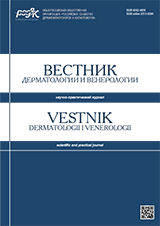Фульминантные акне. Современное решение проблемы
- Авторы: Дрождина М.Б.1
-
Учреждения:
- Кировский государственный медицинский университет Министерства здравоохранения Российской Федерации
- Выпуск: Том 95, № 4 (2019)
- Страницы: 79-86
- Раздел: ФАРМАКОТЕРАПИЯ В ДЕРМАТОВЕНЕРОЛОГИИ
- Дата подачи: 19.10.2019
- Дата принятия к публикации: 19.10.2019
- Дата публикации: 19.08.2019
- URL: https://vestnikdv.ru/jour/article/view/507
- DOI: https://doi.org/10.25208/0042-4609-2019-95-4-79-86
- ID: 507
Цитировать
Полный текст
Аннотация
Описаны современные представления об этиологических факторах, лежащих в основе редкого, тяжелого заболевания — фульминантных акне, влиянии генетических и экспосом-факторов на формирование заболевания, особенностях патогенеза данной формы акне. Выделены основные патогенетические факторы, влияющие на дебют и течение фульминантных акне: Cutibacterium и микробиом кожных покровов в целом; гиперпродукция кожного сала себоцитами при непосредственном участии дигидротестостерона, прогестерона, инсулиноподобного фактора роста-1; особенности врожденного иммунитета, фолликулярный гиперкератоз. Описаны клиника, осложнения и оптимальная терапевтическая тактика на современном этапе. Представлен клинический случай с успешным терапевтическим исходом.
Об авторах
М. Б. Дрождина
Кировский государственный медицинский университет Министерства здравоохранения Российской Федерации
Автор, ответственный за переписку.
Email: drozhdina@yandex.ru
к.м.н., доцент кафедры дерматовенерологии и косметологии,
610998, г. Киров, у л. Карла Маркса, д. 112
РоссияСписок литературы
- Dreno B., Pecastaings S., Corvec S. et al. Cutibacterium acnes (Propionibacterium acnes) and acne vulgaris: a brief look at the latest updates. J Eur Acad Dermatol Venereol. 2018;32(Suppl 2):5–14. doi: 10.1111/jdv.15043
- Palatsi R., Oikarinen A. Hormonal analysis and delayed hypersensitivity reactions in identical twins with severe acne. Acta Derm Venereol. 1979;59(2):157–160.
- Lynn D. D., Umari T., Dunnick C. A., Dellavalle R. P. The epidemiology of acne vulgaris in late adolescence. Adolescent Health Med Ther. 2016;7:13–25. doi: 10.2147/AHMT.S55832
- Zhang M., Qureshi A. A., Hunter D. J., Han J. A genome-wide association study of severe teenage acne in European Americans. Human genetics. 2014;33(3):259–264. doi: 10.1007/s00439-013-1374-4
- Heydenreich G. Testosterone and anabolic steroids and acne fulminans. Arch Dermatol. 1989 Apr;125(4):571–572. doi: 10.1001/archderm.125.4.571b
- Wollina U., Gesina H., Koch A., Kostler E. Case reports: acne fulminans in Marfan syndrome. J Drugs Dermatol. 2005 Jul-Aug;4(4):501–505.
- Dreno B., Bettoli V., Araviiskaia E. et al. The influence of exposome on acne. J Eur Acad Dermatol Venereol. 2018;32:812–819. doi: 10.1111/jdv.14820
- Murillo N., Raoult D. Skin microbiota: overview and role in the skin diseases acne vulgaris and rosacea. Future Microbiol. 2013;8:209– 222. doi: 10.2217/fmb.12.141
- Wolf R., Parish L. C. Effect of soaps and detergents on epidermal barrier function. Clin Dermatol. 2012;30:297–300. doi: 10.1016/j.clindermatol.2011.08.021
- Матушевская Е. В., Антонова Л. А., Матушевская Ю. И., Петрова К. С. Клинический опыт применения системного изотретиноина в лечении тяжелых форм акне. РМЖ. 2018;82(II):109–112.
- Nagy I., Pivarcsi A., Kis K. et al. Propionibacterium acnes and lipopolysaccharide induce the expression of antimicrobial peptides and proinflammatory cytokines/chemokines in human sebocytes. Microbes Infect. 2006;8:2195–2205. doi: 10.1016/j.micinf.2006.04.001
- Placzek M., Degitz K., Schmidt H., Plewig G. Acne fulminans in late-onset congenital adrenal hyperplasia. Lancet. 1999 Aug 28;354(9180):739–740. doi: 10.1016/S0140-6736(99)01862-0
- Hoyt G., Hickey M. S., Cordain L. Dissociation of the glycaemic and insulinaemic responses to whole and skimmed milk. Br J Nutr. 2005;93:175–177. doi: 10.1079/BJN20041304
- Honma M., Murakami M., Iinuma S. et al. Acne fulminans following measles infection. J Dermatol. 2009 Aug;36(8):471–473. doi: 10.1111/j.1346-8138.2009.00680.x
- Brănişteanu D. E., Cotrutz C. E., Luca M. C., Molodoi D. A., Stoica L. E., Ianoşi S. L. et al. Morphopathological stigmata in acne fulminans. Rom J Morphol Embryol. 2015;56(3):1185–1190.
- Dreno B. What is new in the pathophysiology of acne, an overview. J Eur Acad Dermatol Venereol. 2017;31(Suppl 5):8–12. doi: 10.1111/jdv.14374
- Greywal T. L., Zaenglein A., Baldwin H., Bhatia N., Chernoff K. Evidence-based recommendations for the management of acne fulminans and its variants. J Am Acad Dermatol. 2017 Jul;77(1):109–117. doi: 10.1016/j.jaad.2016.11.028
- Wakabayashi M., Fujimoto N., Uenishi T., Danno K., Tanaka T. A case of acne fulminans in a patient with ulcerative colitis successfully treated with prednisolone and diaminodiphenylsulfone: a literature review of acne fulminans, rosacea fulminans and neutrophilic dermatoses occurring in the setting of inflammatory bowel disease. Dermatology. 2011;222(3):231– 235. doi: 10.1159/000324226
- Williamson D. M., Cunliffe W. J., Gatecliff M., Scott D. G. Acute ulcerative acne conglobata (acne fulminans) with erythema nodosum. Clin Exp Dermatol. 1977 Dec;2(4):351–354. doi: 10.1111/j.1365-2230.1977.tb01574.x
- Kim S. Y., Jung S. K., Lee S. G., Yi S. M., Kim J. H., Kim I. H. Acne fulminans with osteolytic change in metaphysis of distal radius. Int J Dermatol. 2016 May;55(5):571–573.
- Gordon P. M., Farr P. M., Milligan A. Acne fulminans and bone lesions may present to other specialties. Pediatr Dermatol. 1997 NovDec;14(6):446–448. doi: 10.1111/j.1525-1470.1997.tb00686.x
- Iqbal M., Kolodney M. S. Acne fulminans with synovitis-acne-pustulosis-hyperostosis-osteitis (SAPHO) syndrome treated with infliximab. J Am Acad Dermatol. 2005 May;52(5. Suppl 1):S118–S120. DOI: 10.1016/j. jaad.2004.09.006
- Kraus S. L., Emmert S., Schön M. P., Haenssle H. A. The dark side of beauty: acne fulminans induced by anabolic steroids in a male bodybuilder. Arch Dermatol. Oct 2012;148(10):1210–1212. doi: 10.1001/archdermatol.2012.855
- Heydenreich G. Testosterone and anabolic steroids and acne fulminans. Arch Dermatol. 1989 Apr;125(4):571–572. doi: 10.1001/archderm.125.4.571b
- Siadat A. H., Bostakian A., Abtahi-Naeini B., Shahbazi M. Successful Treatment of Facial Acne Fulminans: Antimicrobial Agents and Oral Prednisolone as Promising Regimes. Case Rep Dermatol Med. 2017;2017:7092910. doi: 10.1155/2017/7092910
- Кохан М. М., Кениксфест Ю. В., Шайбакова Ю. Б., Полякова Н. В., Топычканова Е. П., Кащеева Я. В. и др. Опыт терапии больных различными формами акне препаратом системного изотретиноина. Клиническая дерматология и венерология. 2014;2:91–99.
- Howard R., Smith G. The readability of iPledge program patient education materials. J Am Acad Dermatol. 2018;79(4):e69-e70. doi: 10.1016/j.jaad.2018.05.038
- Seukeran D. C., Cunliffe W. J. The treatment of acne fulminans: a review of 25 cases. Br J Dermatol. 1999 Aug;141(2):307–309. doi: 10.1046/j.1365-2133.1999.02982.x
- Massa A. F., Burmeister L., Bass D., Zouboulis C. C. Acne Fulminans: Treatment Experience from 26 Patients. Dermatology. 2017;233(2– 3):136–140. doi: 10.1159/000473860
- Zaenglein A. L., Pathy A. L., Schlosser B. J., Alikhan A., Baldwin H. E., Berson D. S. et al. Guidelines of care for the management of acne vulgaris. J Am Acad Dermatol. 2016 May;74(5):945–973.e33. doi: 10.1016/j.jaad.2015.12.037
Дополнительные файлы








